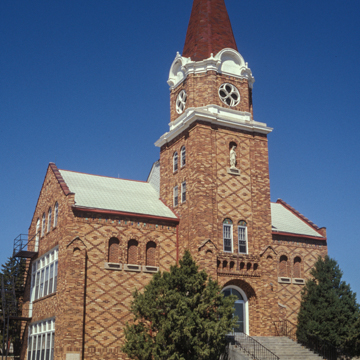The farming and ranching community of Lefor was formed in 1897 by German Hungarian immigrants from the Banat region of Hungary. Historically referred to by locals as the “Queen of the Prairies Church,” it is the third church to occupy this site on a high rise of land. It was preceded first by a sod church and then a stone church that served until this church was dedicated in 1929. Bishop Vincent Wehrle (Wehrle was appointed bishop of the Diocese of Bismarck in 1910) invited Hausler of St. Paul to design this church that can seat 450 and includes six classrooms and a gymnasium. The imposing Romanesque Revival church is constructed of concrete, structural tile, and two-color bricks with extensive diapering. The plan is unusual in the placement of the transept at the front. Large expanses of windows at the south end wall of the transept are subdivided. The robust proportions of the front bell tower are balanced by a spire whose square base has quatrefoil rose windows. Church histories describe the importance to the community of Banat-region German Hungarians of the church bells that were cast in Temeschevor, Hungary. As well as calling worshippers to services, the bells were also rung to warn of fires or other emergencies.
You are here
St. Elizabeth’s Catholic Church
If SAH Archipedia has been useful to you, please consider supporting it.
SAH Archipedia tells the story of the United States through its buildings, landscapes, and cities. This freely available resource empowers the public with authoritative knowledge that deepens their understanding and appreciation of the built environment. But the Society of Architectural Historians, which created SAH Archipedia with University of Virginia Press, needs your support to maintain the high-caliber research, writing, photography, cartography, editing, design, and programming that make SAH Archipedia a trusted online resource available to all who value the history of place, heritage tourism, and learning.















